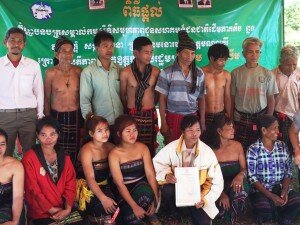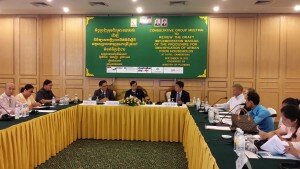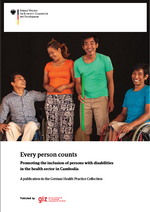Land Tenure Security for Pu Trom Community in Mondulkiri: An indigenous people community is celebrating the receipt of their collective land title
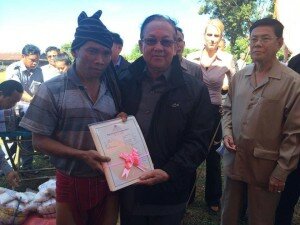
Senior Minister H.E. Im Chun Lim of MLMUPC handing over the collective land title to Mr. Reyeum Pcheul of Pu Trom Community.
30 December 2015
As the ninth of Cambodia’s indigenous peoples communities Pu Trom received its collective land title on November 30th. After successfully passing the various steps of the complex indigenous people communal land titling process, Senior Minister H.E. Im Chun Lim of the Ministry of Land Management, Urban Planning and Construction (MLMUPC) handed over the communal land title to the community representatives during the land titling ceremony in Pu Trom Village.
Since 2005 GIZ’s Land Rights Program is advising MLMUPC in designing, piloting and implementing the process of the indigenous people communities land titling. So far nine communities in Ratanakiri and Mondulkiri received their collective land title. With the support of the Land Rights Program almost 40 more communities qualified for a collective land title and are in the process of receiving it during the next years. More>>>
Land Tenure Security for Pu Trom Community in Mondulkiri: An indigenous people community is celebrating the receipt of their collective land title

Senior Minister H.E. Im Chun Lim of MLMUPC handing over the collective land title to Mr. Reyeum Pcheul of Pu Trom Community.
30 December 2015
As the ninth of Cambodia’s indigenous peoples communities Pu Trom received its
collective land title on November 30th. After successfully passing the various steps of the complex indigenous people communal land titling process, Senior Minister H.E. Im Chun Lim of the Ministry of Land Management, Urban Planning and Construction (MLMUPC) handed over the communal land title to the community representatives during the land titling ceremony in Pu Trom Village.
Since 2005 GIZ’s Land Rights Program is advising MLMUPC in designing, piloting and implementing the process of the indigenous people communities land titling. So far nine communities in Ratanakiri and Mondulkiri received their collective land title. With the support of the Land Rights Program almost 40 more communities qualified for a collective land title and are in the process of receiving it during the next years.
Mondulkiri’s Pu Trom community inhabits 116 families from the ethnic group Bunong. The community jointly owns 1,606ha of land which is split into five different types of land: residential, farming and reserved land for future generations, spiritual forests and burial grounds. The community cultivates and uses the land jointly and preserves it for future generations. With the title in the pocket, Pu Trom’s villagers now got land tenure security. They legally own their land and are officially able to protect it against encroachment and land grabbing.
During the ceremony the four speakers H.E. Im Chun Lim, Senior Minister of MLMUPC, H.E. Eng Bunheang, governor of Mondulkiri, Maraile Görgen from GIZ’s Land Rights Program as well as Mr. Royeum Pcheul community chief of Pu Trom highlighted the importance of the land title for Pu Trom community and all other indigenous communities in Cambodia. For indigenous communities land is much more than the basis for development and wealth. It is the identity and culture of the people and the place of their ancestors and following generations.
The four speakers asked the community to carefully protect the land against encroachments and land grabbing. Even though the community legally owns the land, all villagers have to take care of it. The community acknowledged the advantage of formalized land tenure security and agreed with the speakers about the importance of protecting and preserving the land.
Besides having set ‘official’ concrete boundary markers, the villagers of Pu Trom community set their own boundary markers: Traditional hard wood trees which have a special importance to the community. H.E. Senior Minister Im Chun Lim valued this effort and appreciated the tradition and customs of Pu Trom’s villagers who performed Bunong dances and music during the land titling ceremony.
![]()
Urban IDPoor Ready for Piloting
04 December 2015
September 29, 2015 – Since 2006, GIZ has supported the Cambodian Ministry of Planning (MOP) in developing and implementing a procedure to identify the country’s poor households. By now, the poverty identification in rural areas is a well-established process that is based on a participatory approach executed by villagers themselves, which greatly relies on trust within the community. More >>>
Urban IDPoor Ready for Piloting
04 December 2015
September 29, 2015 – Since 2006, GIZ has supported the Cambodian Ministry of Planning (MOP) in developing and implementing a procedure to identify the country’s poor households. By now, the poverty identification in rural areas is a well-established process that is based on a participatory approach executed by villagers themselves, which greatly relies on trust within the community. Due to different dynamics in urban communities, developing a procedure for participative poverty identification in urban areas is a challenging task that requires dedication and involvement of numerous stakeholders.
In late-September, government officials and other stakeholders such as CSOs, development partners and NGOs convened at the “Consultative Meeting to review the draft implementation manual of the procedure for identification of urban poor”. This advisory session marked a milestone in this consultative process, since it was the last step involving stakeholders before piloting the data collection procedure.
After the members of the consultative group reflected on ways to improve the implementation manual in small discussion groups, their comments and suggestions were taken into account during the last review of the manual by IDPoor Programme experts at the MOP and GIZ in October.
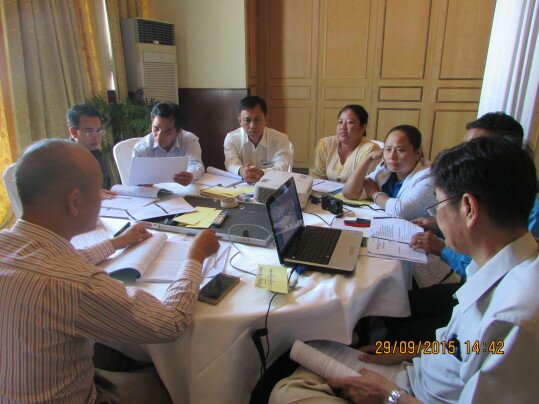
The consultative session was inclusive of a wide-range of stakeholders. Participants’ comments were incorporated into the final draft of the manual for procedures to identify urban poor in Cambodia.
As a result, the draft manual has been finalised and is ready to be piloted. The pilot aims to:
1. Put the procedure for identification of poor households in urban areas into practice according to the implementation manual.
2. Examine whether the procedure is well adapted to the dynamics of urban communities.
3. Identify possible bottlenecks and practical challenges in the implementation of urban IDPoor.
Three provinces will be selected to implement the urban IDPoor pilot in one Sangkat (commune) over the next couple of months. Accordingly, IDPoor experts at GIZ and MOP expect the first urban IDPoor round to begin in 2016.
The IDPoor Programme is supported by the Governments of Australia and Germany through GIZ.
To learn more about IDPoor visit:
http://www.idpoor.gov.kh/
http://www.giz.de/en/worldwide/17300.html
![]()
